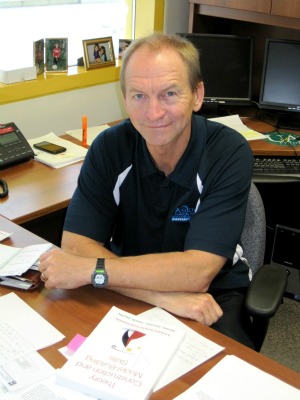
Ian Reade says athletics must contribute to the development and delivery of curriculum to support the university's academic mission
To paint the future, you had best look to your past.
This is precisely where Athletics director Ian Reade is focused as he works with dean Kerry Mummery on a new model for the delivery of high performance sport at the University of Alberta, digging deep into the original intent of the Faculty of Physical Education and Recreation's founding dean, Dr. Maury Van Vliet, more than 40 years ago, when he set forth his vision.
"When Maury Van Vliet created the Faculty I believe he imagined one where every part of it would lend to the fulfilling of the university's academic mission," Reade says. "But, in general, sport at Canadian universities has moved away from that vision -more so than our faculty - but we have as well. We started to separate athletics from academics because the demands to coach far exceeded the capacity of the academic staff to deliver on the demands. That meant the hiring of coaches who were only hired to coach and were involved to a lesser extent in curriculum," he says. "Consequently, our sport development model did not overlap with curriculum. Now, we are bringing curriculum into how we work."
Reade calls this return to Van Vliet's original vision the "Alberta Model" and it's the first such sport development model at any Canadian university.
At the heart of the model is an athlete development and coaching model that's grounded in, influenced by, and interlaced with, the sport curriculum of the faculty, the sport and performance science researchers who engage with Golden Bears and Pandas athletes, and every student - undergraduate and graduate - whose passion this field is. In turn, new science, researchers in the field, emerging scientists and coaches contribute to curriculum development and its delivery through the academic offerings of the faculty.
"The Alberta Model comprises six or seven concepts related to sport that are grounded in curriculum," explains Reade. "The concepts include every aspect of what we do as a faculty that relates to sport such as sport management, performance science, sport psychology, athlete health, and coach education, for example."
For Reade, grounding the high performance sport unit in curriculum is crucial to support the faculty's academic mission. "In the sport context I see relationships between curriculum and teaching; curriculum, coaches and athletes, and curriculum and coaches, research, sport science, sport performance. What emerges, as the concepts fit into the model that the relationships between those concepts eventually lead to the outcomes or metrics by which the faculty measures performance."
While researcher involvement with student-athlete development is nothing new and many faculty members and graduate students conduct research working with Golden Bears and Pandas athletes, Reade says the Alberta Model is formulated to more deeply intertwine and formalise these efforts that often occur somewhat haphazardly, so they are focused on informing curriculum to enhance and focus learning opportunities for students.
"Our researchers have always been involved with our teams, but the Alberta Model plans for that to be done with intent and purpose, rather than happenstance where a researcher takes an interest in a particular year and does that," says Reade. "Currently these contributions to athletics are being driven by individual interests. With this model, this type of engagement will be strategically planned with graduate student opportunity, curriculum in sport and performance science, learnings for undergraduate students and opportunities for researchers dovetailed within a coherent model, running in concert with curriculum and the desire to develop both athletes and young scientists."
Student-athletes will derive benefits too, emphasizes Reade. "Implementing the Alberta Model will mean better evidence-based sport science support for athlete performance. For example, assistant coaches have come from many different backgrounds. In the future, we'd be more likely to have the coaching master's degree students involved," says Reade. "Graduate students will be connected to the newest knowledge in the classes they attend; they will be very committed to the program. Students should be available full time to work with the student athletes and sport science students would be trained to contribute directly to the training of a student athlete.
"As we support and create the right curriculum at the undergraduate and graduate levels, those who are interested in sport will, in the new model, work with those athletes in a purposeful system, driven by our curriculum and teaching mission."
Reade is hopeful that the Alberta Model will also deliver funding relative to any academic unit contributing to learning and discovery in line with the university's academic plan. "When this model is fully realized," says Reade, "the academic administration will start to look at the athletic program in a different way and see that it is really part of the student academic experience. It's much easier for the university to justify spending money on the athletics program then because it fulfills the academic mission - and the Alberta Model is congruent with the university's mission."